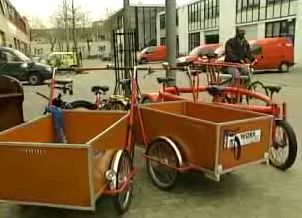As I've said before, I love these workhorse utility bikes and I wish they were readily available in Australia. Meanwhile in Holland the Dutch quest for practical bicycles continues…
(via velorution)
From the video:
The "big" bike industry, as we can call it, has sort of focused on niche markets and sport and recreation and fun and has missed the boat on practicality. They've sort of lost their roots - once upon a time Dutch bikes were strong and black and simple and now they're mostly funny light aluminium things with all kinds of things that no-one wants on them. And we sell these simple solid tough Dutch bikes that bizzarely aren't available from standard manufacturers.
Henry Cutler, founder of WorkCycles
Yeah, we need to think more broadly about what it means to cycle. That's not to say that utility cyling can't also include fun, fitness, and recreation. But primarily it must be practical and mainstream manufacturers don't seem to give practicality as much attention.
Sport vs Utility
The sporting side of cycling has always driven bicycle design. It's enticing to think how different bicycle design would have been if in 1934 the Union Cycliste Internationale had not rejected Francois Faure's one-hour record on a recumbent, thus giving prominence and (sporting) legitimacy only to upright 'safety' bicycles.
The UCI felt it was the rider that mattered, not the machine, an attitude that is still very prevalent in the UCI today (and nothing wrong with it, except its unfortunate effect on bicycle design). The result of this was that bicycle manufacturers would not make recumbents because all the money and prestige was in the UCI approved diamond frame bicycle. This ruling by the UCI exists to this day! In fact, the ruling is even more restrictive now with tight controls on aerobars and aerowheels etc. So ironically, because recumbents are so fast they never got developed.
from Recumbent Bicycles at Recumbent Cycling Ontario
It's not my intention to get into a recumbents vs uprights debate, rather to make the general point that people still have a narrow view of what constitutes "a bicycle". If your purpose is to carry a load and/or travel quickly (as opposed to, say, have a work-out), it's possible that a bicycle with the well-known diamond frame design might not be the best thing for you.
The upshot of the upright bike being the dominant design is that anything that's not a "normal" bike is made in small production runs (often custom-made), and is therefore considerably more expensive than an upright option.
Hmm, this isn't where I thought this little rant would lead but there you go.

Comments
Great post Treadly, it's one of the reasons I don't do much now on uprights at my blog, I'm actively trying to show bicycle transport in a whole range of forms - bikes as utility vehicles.
Here, here! Let's see more work bikes on the streets, and not just being used by couriers/bicycle messangers.
I want to see people taking their shopping home by bike, I want to see people moving furniture by bike, sales reps on bikes plying their stock samples, home delivery services using bicycles.
Every time I see a pizza delivery car on the road I cringe, most of these only deliver in a radius a few kilometres from the shop, why don't they use bicycles? Whatever happened to the paper delivery "boy" on a bike in the mornings? we need to go out there and find "him" again. Damn it, even our snail mail is being delivered by motorcycle .... what ever happened to those red postal service bikes?
Ofcourse I may have a vested interested given that my area of interest lies in pedal-powered passenger services:)
Hey, pedaller, it's sounds as recently if you've had a conversion on the road to Damascus? Changed your opinion now?
lol cfsmtb. I have always believed in the value of work bikes of all types. What I was objecting to with regards the Pedal Powered Vehicles Workshop was the "re-inventing the wheel" approach, ie, the type of designs they were looking at were already commercially available and that the uptake in Australia of these sort of vehicles has been less than slow, so, the time and effort could have been better spent just getting people to ride the bikes they already own but don't use.